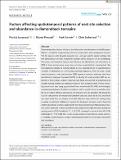Files in this item
Factors affecting spatiotemporal patterns of nest site selection and abundance in diamondback terrapins
Item metadata
| dc.contributor.author | Levasseur, Patricia | |
| dc.contributor.author | Prescott, Robert | |
| dc.contributor.author | Faherty, Mark | |
| dc.contributor.author | Sutherland, Chris | |
| dc.date.accessioned | 2023-03-16T11:30:05Z | |
| dc.date.available | 2023-03-16T11:30:05Z | |
| dc.date.issued | 2023-03-15 | |
| dc.identifier | 283369940 | |
| dc.identifier | 43fd340f-21c6-40ae-8248-ae42f59fa21d | |
| dc.identifier | 85152674404 | |
| dc.identifier.citation | Levasseur , P , Prescott , R , Faherty , M & Sutherland , C 2023 , ' Factors affecting spatiotemporal patterns of nest site selection and abundance in diamondback terrapins ' , Ecology and Evolution , vol. 13 , no. 3 , e9866 . https://doi.org/10.1002/ece3.9866 | en |
| dc.identifier.issn | 2045-7758 | |
| dc.identifier.other | ORCID: /0000-0003-2073-1751/work/131123492 | |
| dc.identifier.uri | https://hdl.handle.net/10023/27195 | |
| dc.description | Funding: Massachusetts Division of Fisheries and Wildlife Natural Heritage and Endangered Species Program. | en |
| dc.description.abstract | Determining what factors influence the distribution and abundance of wildlife populations is crucial for implementing effective conservation and management actions. Yet, for species with dynamic seasonal, sex-, and age-specific spatial ecology, like the diamondback terrapin (Malaclemys terrapin; DBT), doing so can be challenging. Moreover, environmental factors that influence the distribution and abundance of DBT in their northernmost range have not been quantitatively characterized. We investigated proximity to nesting habitat as one potential driver of spatiotemporal variation in abundance in a three-step analytical approach. First, we used a scale selection resource selection function (RSF) approach based on landcover data from the National Landcover Database (NLCD) to identify the scale at which DBT are selecting for (or avoiding) landcover types to nest. Next, we used RSF to predict areas of suitable nesting habitat and created an index of nest suitability (NSI). Finally, analyzing visual count data using a generalized linear mixed model (GLMM), we investigate spatiotemporal drivers of relative abundance, with a specific focus on whether similar factors affect offshore abundance and onshore nest site selection. We found the scale of selection for developed and saltmarsh land use classes to be 550 and 600 m and open water land use classes to be 100. Selection was positive for nesting areas proximal to saltmarsh habitat and negative for developed and open water. Expected relative abundance was best explained by the interaction between NSI and day of season, where expected relative abundance was greater within high NSI areas during the nesting season (2.20 individuals, CI: 1.19–3.93) compared to areas of low NSI (1.84 individuals, CI: 1.10–3.10). Our results provide evidence that inferred spatial patterns of suitable nesting habitats explain spatiotemporal patterns of terrapin movement and abundance. | |
| dc.format.extent | 11 | |
| dc.format.extent | 1880087 | |
| dc.language.iso | eng | |
| dc.relation.ispartof | Ecology and Evolution | en |
| dc.subject | Diamondback terrapin | en |
| dc.subject | Nest selection | en |
| dc.subject | Relative abundance | en |
| dc.subject | Scale selection | en |
| dc.subject | Spatiotemporal variation | en |
| dc.subject | Visual headcount | en |
| dc.subject | QL Zoology | en |
| dc.subject | E-DAS | en |
| dc.subject | SDG 15 - Life on Land | en |
| dc.subject | MCC | en |
| dc.subject.lcc | QL | en |
| dc.title | Factors affecting spatiotemporal patterns of nest site selection and abundance in diamondback terrapins | en |
| dc.type | Journal article | en |
| dc.contributor.institution | University of St Andrews. Statistics | en |
| dc.contributor.institution | University of St Andrews. Centre for Research into Ecological & Environmental Modelling | en |
| dc.identifier.doi | 10.1002/ece3.9866 | |
| dc.description.status | Peer reviewed | en |
This item appears in the following Collection(s)
Items in the St Andrews Research Repository are protected by copyright, with all rights reserved, unless otherwise indicated.

